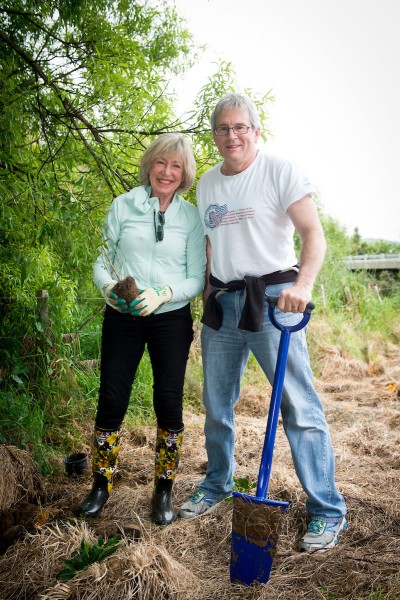Green fingered residents of the local community turned out in support of a community planting day held on Sunday, 29 October 2017 at Lanes Flat, Pāuatahanui.
More than 50 local residents, community group members and councillors donned their gloves alongside project staff and planted 1,000 native trees and shrubs along the banks of the Pāuatahanui Stream.
Darren Utting, Environmental and Stakeholder Manager says this was a significant milestone for the project. “The community planting day marked the start of our planting works, which will see more than 27 kilometres of streams along the new motorway enriched with native vegetation to create a better habitat for native wildlife. In addition, the creation of new wetland areas means that ecological values will be maintained, if not enhanced, in the long term.
“In less than 10 years after the new ecological areas are fully established, the water quality and surrounding environment will be in a better state than before the motorway was built”, he says.
The plants will also help to create a natural buffer for a new community walkway along the Pāuatahanui Stream, which will be opened towards the end of the project.
“We had people of all ages getting their hands dirty planting the trees, with children having fun discovering the many worms and cicadas hiding amongst the dirt, and in a short period of time they had completely transformed that area of the Pāuatahanui Stream.
“They may not realise it now, but in 10, 20 or 30 years, many of the children will be able to say ‘I planted that!’” says Darren.
After a site blessing by Ngāti Toa Kaumatua, Taku Parai, and a demonstration on planting from the project’s landscapers, the volunteers set to the task at hand of planting a selection of natives including species of manuka, coprosma, and kowhai.
Wellington Gateway Partnership CEO Sergio Mejia says a big part of the project is about achieving good long-term environmental outcomes. “We’re focused on ensuring the construction footprint is minimised and then offset by a number of environmental improvements that will see the water quality of local streams and waterways improve over time.
“Around two million native trees and shrubs will be planted on the valleys and slopes surrounding the motorway, including seedlings of giants like tōtara, matai and rimu. This will create one of the most significant lowland native bush areas in the Wellington region and reduce erosion and sediment entering streams and – ultimately – the Pāuatahanui Inlet and Onopoto Arm of the Porirua Harbour.
“I would like to thank the community surrounding our works for all of their ongoing support. We’re here for the long haul, and are committed to being good neighbours in all that we do.”
Sergio says that the Transmission Gully motorway will be the first motorway constructed in New Zealand to achieve GreenroadsTM (external link) silver certification – an international sustainability rating system for road design and construction.
Greater Wellington Regional Councillor, Barbara Donaldson said it was a fun day out. “It was great to see so many of the community taking part in the planting day focused on protecting the environment, and demonstrated how much we can achieve by working together.”
“I must confess Porirua City Councillor, Ross Leggett, did all the digging and I had the easier job of planting, but it was good teamwork between Porirua City and Greater Wellington Regional Councils!”
The CPB HEB JV project team treated volunteers to a free sausage sizzle and coffee afterwards, to say thanks for a job well done.

As part of our ongoing planting works in this area, over the summer, willow trees and weed species currently planted along the banks of the Pāuatahanui Stream will be removed, and replaced next winter with native trees and shrubs, which will enhance the habitat for fish and other wildlife, and maintain the stability of the stream banks.
